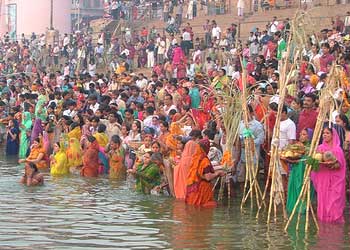
Chhath is an ancient Hindu festival dedicated to Surya, the Hindu Sun God, Surya, also known as Surya Shashti.Chhat Puja, or Dala Chhath Pooja, is an important ritual observed after Diwali in Bihar and other parts of northern and eastern India. The Chhath Puja is performed in order to thank Surya for sustaining life on earth and to request the granting of certain wishes. The Sun, considered the god of energy and of the life-force, is worshiped during the Chhath fesival to promote well-being, prosperity and progress. In Hindu mythology, Sun worship is believed to help cure a variety of diseases, including leprosy, and helps ensure the longevity and prosperity of family members, friends, and elders.
The rituals of the festival are rigorous and are observed over a period of four days. They include holy bathing, fasting and abstaining from drinking water (Vratta), standing in water for long periods of time, and offering prashad (prayer offerings) and aragh to the setting and rising sun.
/photo.cms.jpg)
Date of the festival
Chhath puja is performed on Kartik Shukala Shashti, which is the sixth day of the month of Kartik in the Hindu Calendar, exactly 6 days after Deepawali. This falls typically in the month of October or November in the Gregorian Calendar.
It is also celebrated in the summer (March–April), on Chaitra Shashti, some days after Holi; this event is called Chaiti Chhath.[6] The former is more popular because winter is the usual festive season in North India, and Chhath, being an arduous observance, requiring the worshipers to fast without water for more than 24 hours, is tougher to undertake in the Indian winters
Days Of Chhat
The first day of Chhat is known as Nahai Khai. Devotees take bath in River Ganges – a symbolic act of purification. Houses are thoroughly cleaned and people prepare for the intense austerity. Vegetarian food is preferred during the period of vrat.
The second day is known as Kharna. Fast or Upvaas begins on the second day and this is referred as Kharna. The fast is broken after performing a puja at home in the evening. Kheer, sweets and fruits are offered to deities and then the whole family shares the prasad. Another round of fasting begins after the prasad is shared. This fast is usually broken on the fourth day morning.
The Third day is spent preparing the prasad (offerings) at home. On the eve of this day, the entire household accompanies the parvaitins to a riverbank, pond or a common large water body to make the offerings (Aragh) to the setting sun. It is during this phase of Chhath Puja that the devotees offer prayers to the setting sun.In the evening pujas are performed at home and a special puja is done for Agni – fire god. This puja is performed in a special area cordoned off by four sugarcane sticks.
The fourth day morning, devotees repeat the rituals performed on the third day evening for rising sun and this is known as Chhat Sooryodaya Argh. What is left after offering to the Sun God is shared as prasad and the Chhat Puja comes to an end.
Benefits of Chhath Puja
- The Chhath practice improves the immunity of the Vratti’s body.
- Antiseptic effect: Safe radiation of sunlight can help cure fungal and bacterial infections of the skin.
- Raktavardhak (increase in fighting power of blood): As a consequence of the practice of Chhath, the energy infused in the blood stream improves the performance of white blood cells.
- The solar energy has a great influence on the glands, which results in balanced secretion of hormones.
- Energy requirements are met by the solar energy directly. This will further detoxify the body.
- A state of creative calmness will prevails in the mind.
- To a great extent, all negative responses have their origin in the disturbed flow of prana. With the pranic flow regularized, the duration and frequency of occurrences of anger, jealousy, and other negative emotions will be reduced.
- With patient and sincere practice, the psychic powers like intuition, healing, and telepathy awaken. This depends on the concentration with which the practice is undertaken.

Video
src-wikipedia & youtube

No comments:
Post a Comment